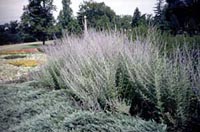Resource Library
Plant of the Week: Sage, Russian
The University of Arkansas System Division of Agriculture does not promote, support or recommend plants featured in "Plant of the Week." Please consult your local Extension office for plants suitable for your region.
Plant of the Week
Russian Sage
Latin: Perovskia atriplicifolia

Now that the Cold War is over – and especially since we won – it's OK to avail ourselves
of things Russian.
Even though the Latin name honors a Russian general, V. A. Perovski (1763-1857),
it is not unpatriotic to plant this lovely plant in your garden. This tough, gray-leafed,
semi-woody shrub is an ideal addition to the perennial border or flower bed where
its light blue flowers form a misty-blue haze during the heat of summer.
Russian sage is one of six Arkansas Select plants for 2000 that gardeners can find
at local nurseries and garden centers. The Arkansas Select program is a joint effort
of the Department of Horticulture at the University of Arkansas, the Cooperative Extension
Service and the Arkansas Nurseryman’s Association that was established three years
ago to identify tough, underused plants for the Arkansas landscape.
Russian sage grows about three feet tall and two feet wide with delicate, gray-green
leaves that are feather-like and to two inches long. The foliage is widely spaced
and the plants have an open, airy look. The plant is a member of the mint family with
light blue flowers produced at the ends of the stems in midsummer in spikes. It is
native across a wide section of Eurasia, including parts of Afghanistan, Russian and
even northwestern China. This plant is one of the few green things that grow in the
arid regions along the old Silk Road out of China and no doubt served as camel browse
as pack trains carried cargo to and from the Middle Kingdom over the past centuries.
While the perennial has been offered by Wayside Garden since the 1930s, it was not
until John Creech, with the U.S. National Arboretum, took a plant collecting trip
through Russia in the 1960s that its popularity seems to have caught on with gardeners.
The Perennial Plant Association named Russian sage the perennial plant of the year
in 1995.
The Russian sage is an ideal plant for combining in the perennial border because
its soft, gray foliage blends well with plants of any texture or color and softens
their impact. Its spiky blue flowers blend well with other flower colors without clashing.
It can also be used at the back of the annual or perennial border as a background
or singly as a specimen. A single plant of Russian sage in the midst of a planting
of Blue Rug Juniper would make an elegant statement.
Growing the Russian sage is easy. The plants are extremely drought tolerant, so don’t
put them in a poorly drained soil, especially if it is wet in the winter. It should
be planted in full sun. Once established it has tremendous drought tolerance. Each
spring the plants should be cut back to six or eight inches from the ground and new
growth encouraged from low down on the plant. No significant pests have been reported
on the plant.
By: Gerald Klingaman, retired
Extension Horticulturist - Ornamentals
Extension News - April 28, 2000
The University of Arkansas System Division of Agriculture does not maintain lists of retail outlets where these plants can be purchased. Please check your local nursery or other retail outlets to ask about the availability of these plants for your growing area.